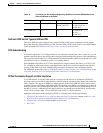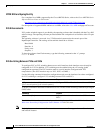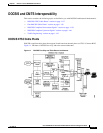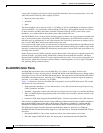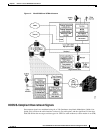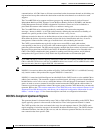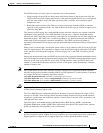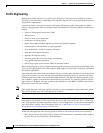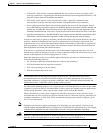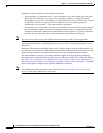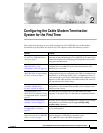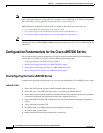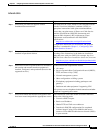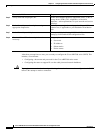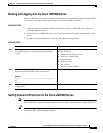
1-143
Cisco uBR7200 Series Universal Broadband Router Software Configuration Guide
OL-2239-05
Chapter1 Overview of Cisco uBR7200 Series Software
DOCSIS and CMTS Interoperability
• VoIP traffic, which requires constant bandwidth, has low tolerance to latency and jitter, and is
typically symmetrical—supporting the same data rate in downstream and upstream directions. VoIP
generally requires phase-lock and jitter attenuation.
• VPN traffic, which requires secure transmissions; traffic is typically symmetrical since
telecommuters exchange more data upstream than residential Internet access customers.
• Video, which can include digital video channels based on the services in your network; current
Cisco uBR7200 Series products support EuroDOCSIS operation where data is MPEG encoded and
packed into an 8 MHz RF channel spacing based on the channel plan used and equipment at the
headend or distribution hub. Video flows in one direction and control information flows in the other.
• Signaling and maintenance—the DOCSIS MAC layer support includes DOCSIS encapsulation, initial
maintenance, station maintenance, registration, frequency hop, and upstream channel changes.
You have a wide range of options to engineer your network. Define your network based on your cable
facilities—headend or distribution hub—and your anticipated service offerings, subscription, and
required service levels. Define data requirements relative to the number of subscribers to support and
their usage patterns. Select upstream symbol rate, modulation format, and other parameters based on
data requirements and return path characterizations.
If the service is asymmetrical, determine the ratio of downstream to upstream data rates. For basic
Internet access where the majority of traffic is sent to a subscriber and the subscriber sends only a small
amount of data upstream, use ratios ranging from 5:1 to 10:1.
Determine what data rate the service should support. Define the maximum and minimum data rate,
answering the following questions:
• Do you want to define the minimum data rate relative to the maximum?
• Will the minimum data rate equal the maximum?
• Will it be a percentage of the maximum?
• Will the minimum data rate be zero?
Note The minimum data rate has the greatest impact on the network. The network must be sized to
accommodate this level of traffic to fulfill the defined service data requirements. The amount of
bandwidth available to a group of subscribers establishes where, within the defined maximum and
minimum data rates, a subscriber within a group is able to operate.
For video traffic planning purposes, use a typical bit rate to calculate densities of video streams within
a channel. For QoS calculations, limit the number of video streams per channel to prevent packet drops.
The key traffic parameter is how many IP video streams will fit into the RF channel.
Ideally, the network is sized so that it supports all subscribers being active at the same time at the
maximum data rate. This results in an expensive network, however, where full capacity, particularly for
residential subscribers, is rarely used. Cisco recommends designing your network to support a given
level of over-subscription.
Note Configure your network to support a percentage of all subscribers at a given data rate. At this level, the
network supports the bandwidth needs of all active users. Provided the over-subscription rate is low enough,
such that service definitions are met, all subscribers receive the service to which they subscribed.
Caution With over-subscription, the network is unable to support all subscribers being active at the maximum
data rate. If the over-subscription is severe enough, subscribers may be denied service.



